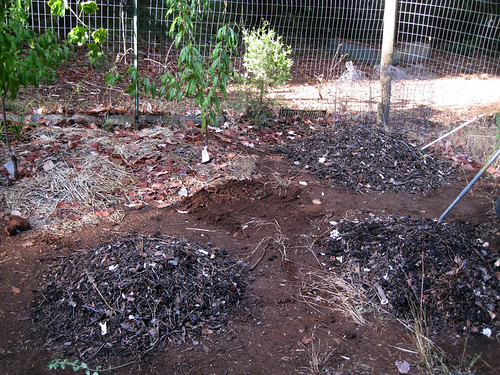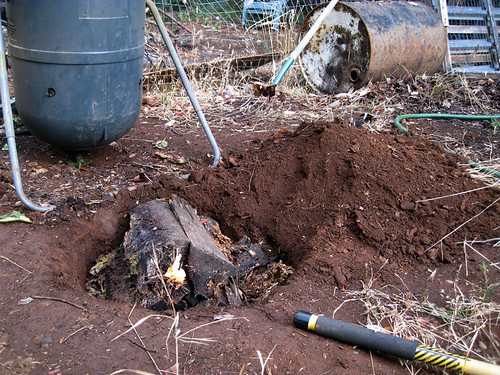In a previous post, I described preparing a future planting site by burying horse food. This weekend, I created an actual, official hügelkultur mound, using a big old rotten log, as well as two other mounds, one filled with forest floor duff, and one with alternating layers of unfinished compost and forest floor duff.
The duff didn’t actually come from the forest floor, but from the garage/studio/guesthouse roof, where it had been accumulating (thanks to overhanging cedar, pine and madrone trees) for perhaps 3 or 4 years. It makes wonderful mulch, so I figured I’d bury it and see what happens. If I had to guess, I’d say burying the materials (duff and wood) will probably lower the soil pH, creating localized slightly acidic conditions. Fortunately, most plants prefer slightly acid soil, so I’m not overly concerned.

Mound #1 (left): Compost + duff. Mound #2 (right foreground): Hugelkultur proper. Mound #3 (right background): Duff
Incorporating a lot of wood and woody materials into the soil creates (at least initially) a nitrogen deficit, as all the local bacteria burn up any available nitrogen as they endeavor to break down the wood. Keeping this in mind, I planted each hill with a leguminous soil builder mix – beans, peas, vetch, oats and rye – just as I did with the horse food mound. I’m hoping that the cover crop, combined with the effects of time – I’m not planning on planting into any of these mounds for about six months – will mitigate any nitrogen deficit, leaving me with some nice, rich, well draining soil.
I plan to plant these mounds with fruit trees in the spring. This particular part of the garden is host to recently planted dwarf peach and nectarine trees (they’re in the background of the picture above), and I’d like to add perhaps one more nectarine, a jujube, and maybe a sea-buckthorn to the mix.



Pingback: Feed Your Soil, Not Your Plants: Cover Croppin’ | food|forest|garden